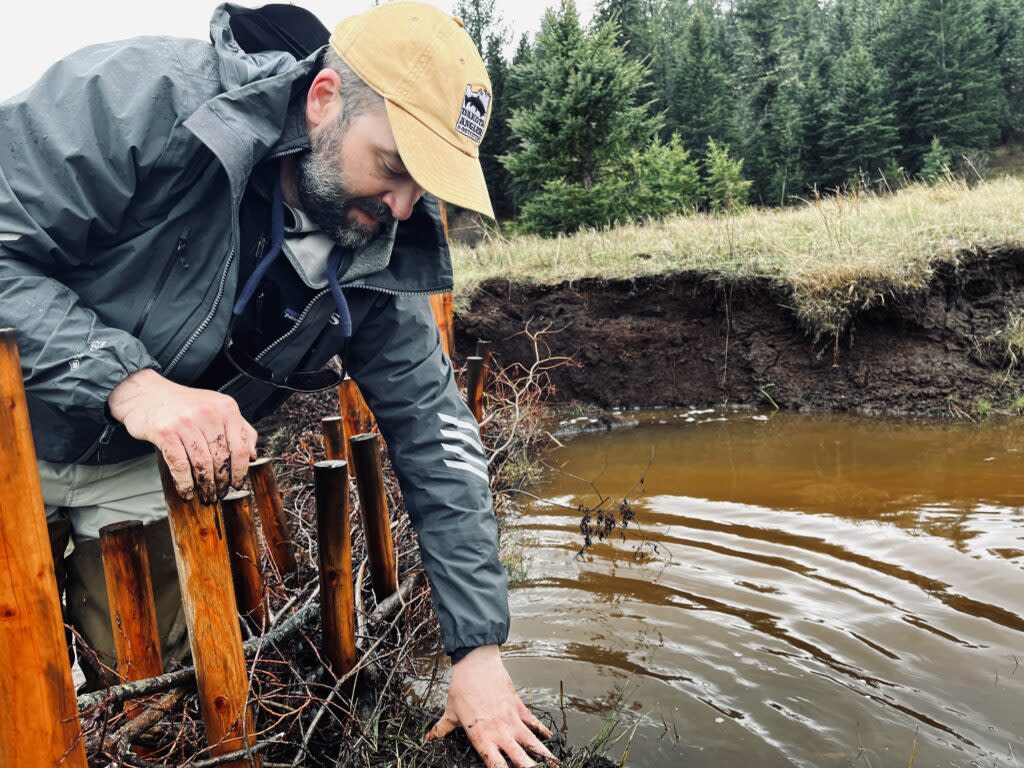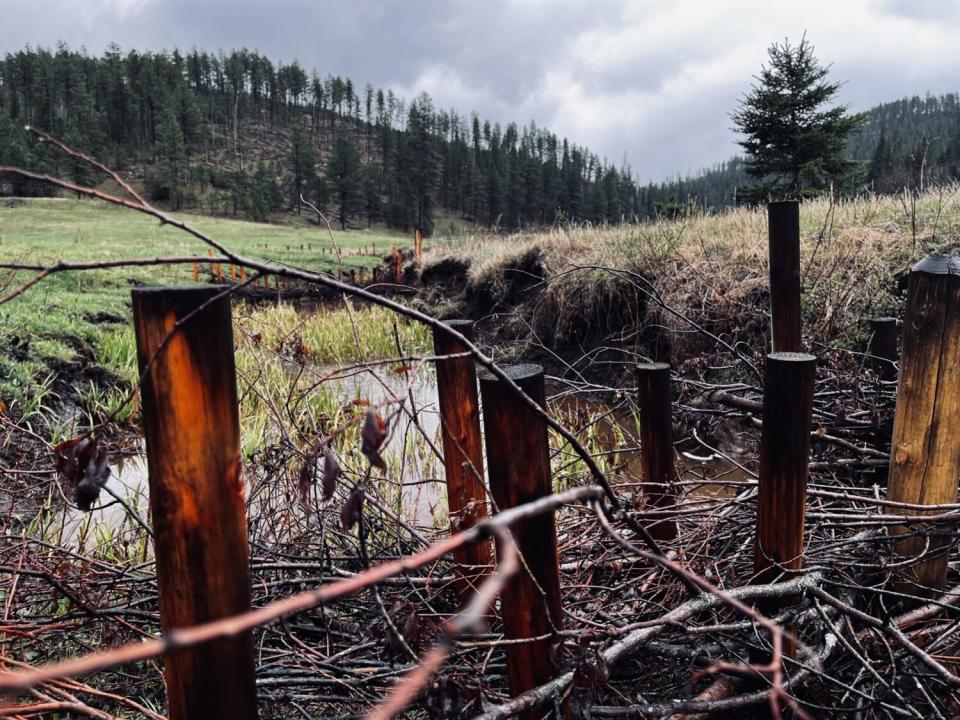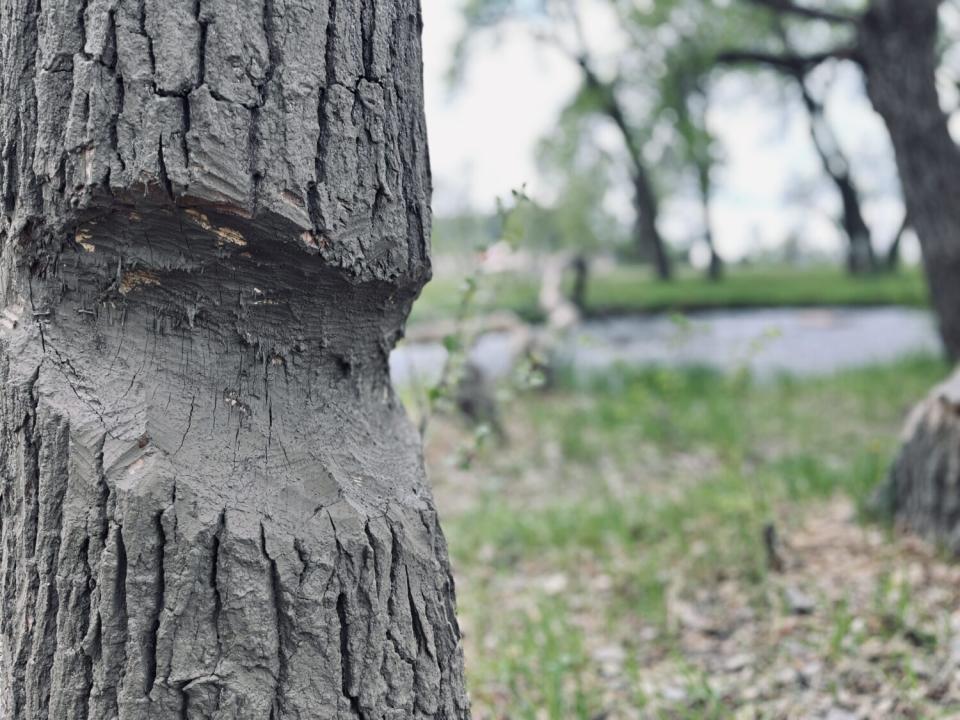Rodent or riparian restorer: East-west views diverge as state considers beaver protections

Hans Stephenson, owner of Dakota Angler & Outfitter in Rapid City, helps do maintenance work on a beaver dam analog in the Black Hills. (Joshua Haiar/South Dakota Searchlight)
Some Black Hills residents have a growing appreciation for large rodents with environmental engineering prowess: beavers.
The admiration spans from foresters to anglers and ranchers. It stems from beavers’ role in mitigating forest fires, retaining water during drought, and creating and maintaining wetland habitats.
However, this newfound enthusiasm emerges as state data indicates a decline in the Black Hills beaver population.
The state Department of Game, Fish and Parks periodically surveys the number of locations where beavers have stored food for the winter. There was a 73% drop in the number of those locations from 2012 to 2023, indicating severe population stress, according to the department.
At the May 2 Game, Fish and Parks Commission meeting, commissioners rejected petitions from Nancy Hilding of the Prairie Hills Audubon Society to reduce beaver trapping or require better monitoring of trapping in the Black Hills. But some commissioners suggested the department should draft its own proposal to achieve similar goals.
Commission Vice Chair Travis Bies said the state needs to alleviate pressure on the Black Hills beaver population.
“Something needs to be done, more than what we’re doing,” Bies said.
He pointed out the folly of allowing year-round beaver trapping in much of the state while also investing in beaver reintroduction efforts in the Black Hills.
Beaver dam analogs
The reintroduction effort includes installing human-made beaver dams – called beaver dam analogs – along creeks with deeply eroded streambeds and banks, with a goal of reintroducing beavers to some of those locations.
Deeply cut streams flow fast and rarely overflow or cause the water table to rise in surrounding land. If the streams had beaver dams, they would hold more water in the soils in the floodplain, which helps support grazing and mitigates the effects of drought and wildfires.
Floodplains with beavers also provide productive grazing land for cattle ranchers during a drought, according to Lori Brown, western South Dakota rangeland specialist with the Nature Conservancy. She said beaver dam analogs have long been used by ranchers in other Western states, and more recently became popular among western South Dakota ranchers.
“We’ve seen the benefits already,” said Brown, who’s also a rancher. “Fire mitigation, water storage, there is tangible economic value we can tie to beavers on the landscape.”
Krista Ehlert is a South Dakota State University assistant professor and range specialist. She said 80% of prairie life comes from only 2% of the land: riparian zones along creeks and streams.
“They’re the vein of blood that feeds prairies,” she said.
Ehlert said a study in Oregon found the land near beaver-dammed creeks and streams benefitted from a 20% increase in vegetation and a 200% increase in the area holding water late in the grazing season.
“You have forage that is staying greener longer,” she said.
But there’s more work needed to bring beavers to the analogs, according to Black Hills National Forest Rangelands Management Specialist Matt Scott.
He said his team, partners and volunteers have installed around 200 beaver dam analogs in the Black Hills. They look for locations with water flow conditions that will not break what they build, and suitable beaver vegetation.
“If they don’t have that willow and aspen to eat, they’re not going to stick around,” he said.

Scott said that the goal is to create a home where the rodent then does the maintenance work. He said the newly created wetland habitats filter the water, mitigate downstream flooding, prevent excessive soil erosion by regulating streamflow, and bring more life to the Black Hills by creating habitat for fish, wildlife and insects.
Additionally, because the floodplain near a stream becomes soaked when dozens of beaver dam analogs are installed every 100 feet or so, investments into beavers are also seen as wildfire mitigation.
“Instead of having to jump two feet, that fire now has to jump 200 feet,” Scott said.
Beaver believers
The benefits have turned Hans Stephenson into a beaver believer. He is a Black Hills Fly Fishers board member and owns Dakota Angler & Outfitter in Rapid City, meaning his business and lifestyle depend on plentiful and healthy trout habitats.
He has been helping with efforts to bring more beavers to the Black Hills.
“Pretty much every stream in the Black Hills is incised,” Stephenson said, referring to deeply cut streams. He said trout benefit from the ponds that beaver dams create, and those habitats can become prime fishing spots.
“A lot of my time anymore is spent thinking about this,” he said. “I want to get as many of these analogs on Rapid Creek as we can.”
In Rapid City, beavers are viewed less favorably because they’ve chewed down trees in the parks along Rapid Creek. But now that there are more beaver dam analogs installed along creeks higher in the Black Hills, they can be live-trapped and relocated.
“We don’t know how many there are, but there are a lot of them in town,” Stephenson said.
To mitigate beaver damage to trees in Rapid City, volunteers and city officials are covering the bottom of some trees with a coat of bark-colored paint mixed with sand, which they hope will deter beavers.

Stephenson first learned of the benefits of beavers while reading “Eager: The Surprising, Secret Life of Beavers and Why They Matter.”
Ben Goldfarb wrote the book. He’s excited to see the tide shifting in western South Dakota.
“I now meet more ranchers who love beavers than hate them,” Goldfarb said. “And these are people whose dads shot beavers, and whose dad’s dad shot beavers.”
East River vs. West River
Views on beavers are different in farm-laden eastern South Dakota, where wetlands are sometimes drained with perforated pipes buried in the ground to manage moisture in fields.
“In the row crop community, there is definitely less tolerance and acceptance of beavers,” Goldfarb said.
The divide was on display during the recent GF&P Commission meeting at Custer State Park.
“I really do think we should shut the trapping down in the Black Hills for now,” said Commission Vice-Chair Bies, a rancher from Fairburn on the edge of the Black Hills.
Meanwhile, Commissioners Julie Bartling of Gregory and Robert Whitmyre of Webster said the beaver situation is different farther east, where many landowners see beavers as pests that flood cropland, block drainage systems and damage trees.
“I can’t speak to what happens out here,” Bartling said of the Black Hills.
Trappers can pursue beavers from January 1 to March 31 on national forest land in the Black Hills. From November 1 to April 20, they can trap on non-national forest land in the Black Hills.
Elsewhere in the state, beavers can be trapped year-round. The state does not require trappers to report the numbers of beavers they catch.
From fur trade to a nuisance
Before European settlement in North America, the beaver population was an estimated 100 million to 200 million.
European trappers valued beaver pelts for the fur trade, particularly for making fashionable hats back in Europe. The demand led to widespread trapping during the 17th and 18th centuries, drastically reducing beaver populations.
The alteration of landscapes for farms, ranches and cities reduced areas available for beaver habitats. Wetlands were drained and streams were diverted, further diminishing the suitable environments necessary for beaver survival.
By the late 19th century, beavers were nearly wiped out in many parts of the United States.
Conservation efforts began in the early 20th century, including reintroduction projects and habitat restoration, which have helped to recover the beaver population to around 10 million to 15 million.
In South Dakota, beavers are one of the animals targeted by the state Game, Fish and Parks’ Wildlife Damage Management program. People can contact the department and ask it to trap or shoot beavers, deer, coyotes, geese and other animals that are damaging property, killing livestock or causing other problems.
The department received 430 requests for help with beavers in 2023 and eliminated 1,126 of them, while spending $304,251 on those efforts. Most beaver-related requests came from counties east of the Missouri River such as Lincoln, Minnehaha, Roberts, Day and Brown, and also from Gregory County on the river’s western bank.
GET THE MORNING HEADLINES DELIVERED TO YOUR INBOX SUPPORT NEWS YOU TRUST.
The post Rodent or riparian restorer: East-west views diverge as state considers beaver protections appeared first on South Dakota Searchlight.

